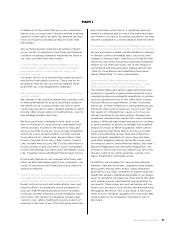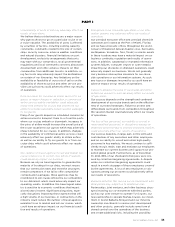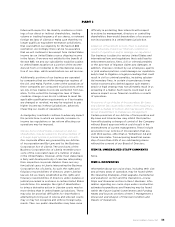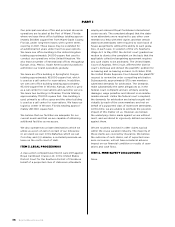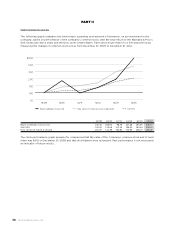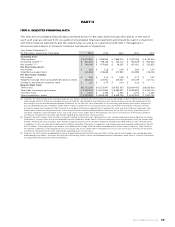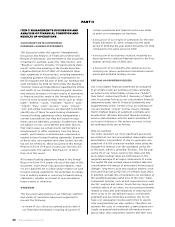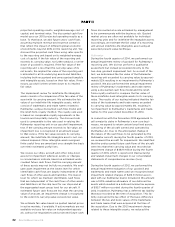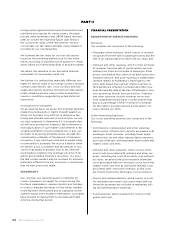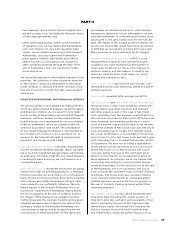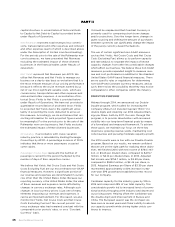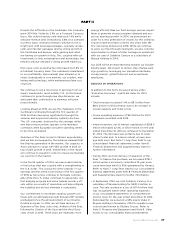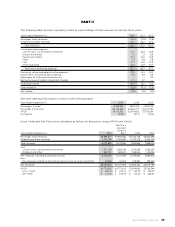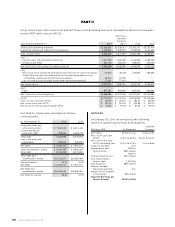Royal Caribbean Cruise Lines 2014 Annual Report Download - page 41
Download and view the complete annual report
Please find page 41 of the 2014 Royal Caribbean Cruise Lines annual report below. You can navigate through the pages in the report by either clicking on the pages listed below, or by using the keyword search tool below to find specific information within the annual report.
40 Royal Caribbean Cruises Ltd.
ITEM 7. MANAGEMENT’S DISCUSSION AND
ANALYSIS OF FINANCIAL CONDITION AND
RESULTS OF OPERATIONS
CAUTIONARY NOTE CONCERNING
FORWARD -LOOKING STATE MENTS
The discussion under this caption “Management’s
Discussion and Analysis of Financial Condition and
Results of Operations” and elsewhere in this document,
including, for example, under the “Risk Factors” and
“Business” captions, includes “forward-looking state-
ments” within the meaning of the Private Securities
Litigation Reform Act of 1995. All statements other
than statements of historical fact, including statements
regarding guidance (including our expectations for
the first quarter and full year of 2015, our earnings and
yield estimates for 2015 set forth under the heading
“Outlook” below and expectations regarding the timing
and results of our Double-Double Program), business
and industry prospects or future results of operations
or financial position, made in this Annual Report on
Form 10-K are forward-looking. Words such as “antic-
ipate,” “believe,” “could,” “estimate,” “expect,” “goal,”
“intend,” “may,” “plan,” “project,” “seek,” “should,”
“will,” and similar expressions are intended to further
identify any of these forward-looking statements.
Forward-looking statements reflect management’s
current expectations but they are based on judg-
ments and are inherently uncertain. Furthermore, they
are subject to risks, uncertainties and other factors,
that could cause our actual results, performance or
achievements to differ materially from the future
results, performance or achievements expressed or
implied in those forward-looking statements. Examples
of these risks, uncertainties and other factors include,
but are not limited to, those discussed in this Annual
Report on Form 10-K and, in particular, the risks dis-
cussed under the caption “Risk Factors” in Part I,
Item 1A of this report.
All forward-looking statements made in this Annual
Report on Form 10-K speak only as of the date of this
document. Given these risks and uncertainties, read-
ers are cautioned not to place undue reliance on such
forward-looking statements. We undertake no obliga-
tion to publicly update or revise any forward-looking
statements, whether as a result of new information,
future events or otherwise.
OVERVIEW
The discussion and analysis of our financial condition
and results of operations have been organized to
present the following:
• a review of our critical accounting policies and of
our financial presentation, including discussion of
certain operational and financial metrics we utilize
to assist us in managing our business;
• a discussion of our results of operations for the year
ended December 31, 2014 compared to the same
period in 2013 and the year ended December 31, 2013
compared to the same period in 2012;
• a discussion of our business outlook, including our
expectations for selected financial items for the first
quarter and full year of 2015; and
• a discussion of our liquidity and capital resources,
including our future capital and contractual commit-
ments and potential funding sources.
CRITICAL ACCOUNTING POLICIES
Our consolidated financial statements are prepared
in accordance with accounting principles generally
accepted in the United States of America (“GAAP”).
(See Note 1. General and Note 2. Summary of Signifi-
cant Accounting Policies to our consolidated financial
statements under Item 8. Financial Statements and
Supplementary Data). Certain of our accounting poli-
cies are deemed “critical,” as they require manage-
ment’s highest degree of judgment, estimates and
assumptions. We have discussed these accounting
policies and estimates with the audit committee of
our board of directors. We believe our most critical
accounting policies are as follows:
Ship Accounting
Our ships represent our most significant assets and
are stated at cost less accumulated depreciation and
amortization. Depreciation of ships is generally com-
puted net of a 15% projected residual value using the
straight-line method over the estimated useful life
of the asset, which is generally 30 years. The 30-year
useful life of our newly constructed ships and 15%
associated residual value are both based on the
weighted-average of all major components of a ship.
Our useful life and residual value estimates take into
consideration the impact of anticipated technological
changes, long-term cruise and vacation market condi-
tions and historical useful lives of similarly-built ships.
In addition, we take into consideration our estimates of
the weighted-average useful lives of the ships’ major
component systems, such as hull, superstructure, main
electric, engines and cabins. Given the very large and
complex nature of our ships, our accounting estimates
related to ships and determinations of ship improve-
ment costs to be capitalized require considerable
judgment and are inherently uncertain. We do not
have cost segregation studies performed to specifi-
cally componentize our ship systems. Therefore, we
estimate the costs of component systems based prin-
cipally on general and technical information known
about major ship component systems and their lives
PART II



